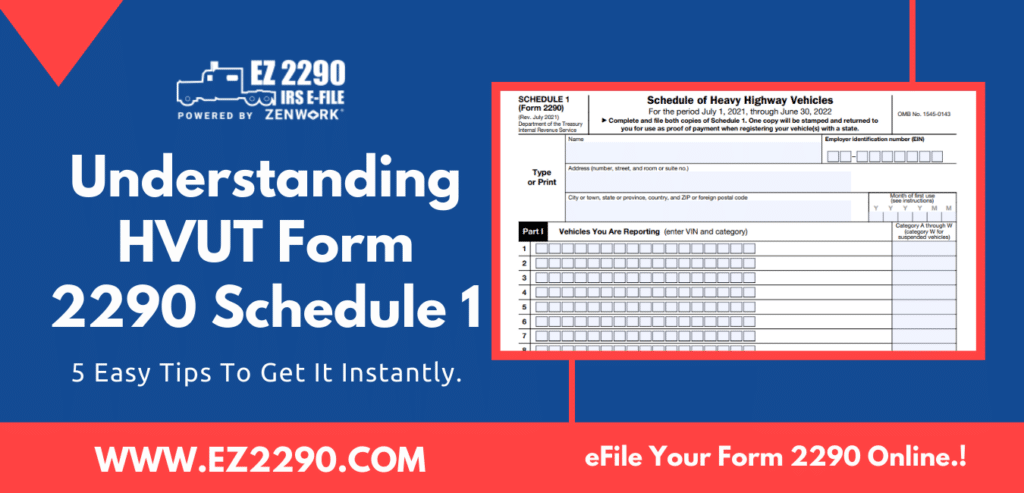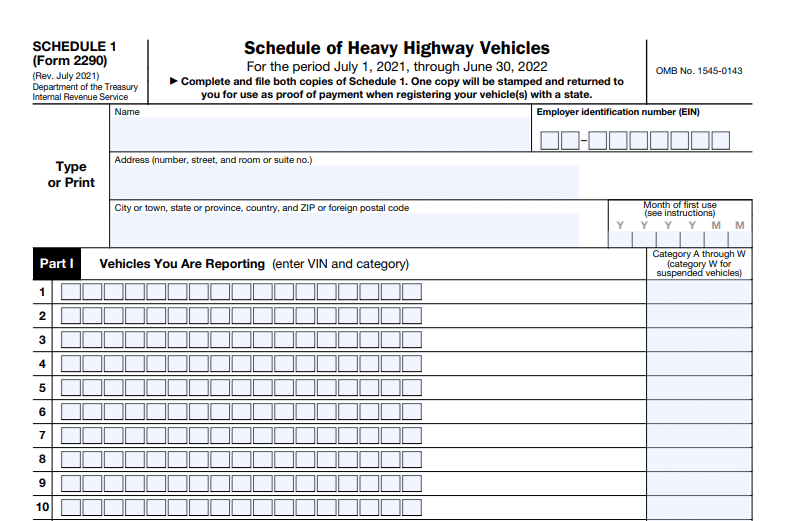
Learn the significance 2290 Schedule-1 holds in HVUT compliance + 5 easy tips to receive IRS Stamped Schedule-1 instantly.
When we buy food online or go to a restaurant and order some food, the seller provides a receipt – a piece of document that contains the items for which you have placed the order, and the payment details. Once you have made the payment, the receipt is stamped as ‘paid’. This denotes that the payment was successful.
Now, try applying this logic to your HVUT taxes. By paying your HVUT taxes to the IRS, you are transacting with the IRS. But how would you know that the IRS has acknowledged your payment?
That’s when Schedule-1 comes into the picture.
What Is Form 2290 Schedule 1?
Broadly, Schedule-1 is a tax form used by the filer to report the vehicle identification numbers (VINs), the month in which the vehicle was first used, business information, EIN, and other details.
Every Form 2290 comes with two copies of Schedule-1. Both copies of Schedule-1 must be filled and submitted by the filer.
However, only one of the submitted copies will be returned to the filer by the IRS after the submission and tax payment have been acknowledged.
This returned copy is treated as ‘Proof of Payment’ of the taxes.
Once the IRS validates and approves your reports, a copy of Schedule-1 is stamped by the IRS as ‘Accepted’. This little stamp means compliance for businesses.
Hence, businesses and tax professionals alike try their best to get the IRS-Stamped Schedule-1 on the first try.
Why Should I Use Schedule 1 (Form 2290)?
Filers must use Schedule-1 to ensure the accuracy of reports and HVUT compliance.
You see, 2290 Schedule-1 reports the vehicle identification numbers (VINs), Employer Identification Number (EIN), the period in which the vehicle was first used, and other business details.
Schedule-1 helps the IRS validate the information reported and track the vehicle tax history.
Essentially, all the VINs reported on Schedule-1 are verified by the IRS to check if the previous vehicle owners addressed their vehicle tax liabilities. The EIN/Name combination is also validated to check if the details match the IRS records.
Who Must File Form 2290 & Schedule 1?
Trucking businesses, fleet owners, and tax professionals who are filing Form 2290 on behalf of their clients are required to file Form 2290.
Vehicles must weigh 55,000 pounds or more to be categorized as ‘Heavy Vehicles’. Heavy vehicles that are used for commercial and agricultural purposes must utilize a mileage of 5000 miles or more, and 7500 miles or more (for agricultural vehicles) in a year.
Apart from trucking businesses, any individual or entity that uses heavy vehicles, such as vans, trucks, carriers, and other vehicles for transportation of goods or material, must file and report with HVUT Form 2290, and document Schedule-1 as ‘Proof of Payment’.
Useful Link: See Who Is Exempt From HVUT Filings
Form 2290 Schedule 1 Instructions

Name & Address
On the face of it, this field may seem very simple. But it is important to know that the IRS is not asking for your personal information here. The IRS is asking for the ‘Doing Business As’ name or the name of the business. The address field must be completed with the business address (operational location).
Vehicle Details
Schedule 1 requires you to enter the vehicle identification numbers of each vehicle for which you’re reporting with Form 2290. The category of the vehicle must also be reported next to the VIN section (as seen in the image above) to communicate to the IRS about the category in which each of your vehicles falls.
Schedule 1 (Form 2290) – Month Of First Use
Do note that you are reporting vehicles that are already registered. Vehicles that are not registered or vehicles for which the status of registration is not clear must not be reported in Schedule-1.
It is also important to understand that the ‘Month of First Use’ is for the period in which the vehicles were first used. The month applies to all the vehicles you’re reporting. For example, if you have started using the vehicles in July 2020, then you must report it as ‘202007’.
Schedule 1 (Form 2290), Consent To Disclosure Of Tax Information
This section of Form 2290 allows you to confirm that you have tried your best to furnish the most recent and accurate information to ensure compliance.
By signing in this section, you are allowing the IRS and assigned parties to review the confidential information you’re reporting.
This step is especially crucial when you outsource your 2290 e-Filing to third-party service providers or tax professionals who manage your e-files on your behalf.
5 Tips To Get IRS-Stamped Schedule-1 Instantly
- Accurate Reports
Ensure that you enter the validated and verified information. Any inaccuracies in reports will result in rejected submissions, repetition of the filing process for corrections, and even penalties.
- Tax Transparency
Maintain tax transparency when reporting your vehicles to the IRS. Hiding your vehicle information in order to reduce your tax liability will have a counter effect. You will end up being penalized by the IRS, making you pay double or even triple the amount of the original tax you owe.
- TIN Matching
Search the IRS database to validate the TIN/Name combination that you’re about to report in the form. If you are a tax professional, it is essential to validate your client’s information. If you’re a business, verify your details against the IRS records just to be sure.
- VIN Validation
If you have reported an incorrect VIN previously or if you’re not sure about the validity of the VIN, then you must most definitely practice VIN validation. A quick VIN Lookup allows you to check if you have the right VIN or if there are any errors.
- Tax Discipline
It is common knowledge that not practicing tax discipline will result in rejected submissions and penalties. Being penalized by the IRS does not look good on your business profile, and may lead to missing out on potential investors (because no one wants to associate with a non-compliant business).
How Can I File Schedule 1 (Form 2290) Online With EZ2290?
You cannot file Schedule-1 as a separate form. However, you must attach both copies of the completed Schedule-1 with Form 2290 and submit the same to the IRS.
Once submitted, the IRS may accept or reject your submission after a meticulous review process.
You can file Form 2290 online through EZ2290 – an IRS-authorized e-file service provider.
- Secure and encrypted e-files
- E-file for multiple vehicles at once easily
- Smart Tax Calculator to instantly calculate your HVUT taxes
- Instantly receive IRS-Stamped Schedule-1
- Tax assistance for rejected files at no additional cost
- Uninterrupted service and 24×7 support
Stamped Copy Of Schedule 1 As Proof Of Payment
With paper files, you receive the ink-stamped Schedule-1.
When you e-File with EZ2290, you will receive the IRS-stamped Schedule-1 within minutes after successful submission. You will receive an electronic copy of Schedule-1 with a digital watermark of the IRS stamp, aligned to the center of the document. Download and print out the document.
If you want Schedule-1 for a previous submission, you will have to send a written request to the following address: Internal Revenue Service 7940 Kentucky Drive Florence, KY 41042-2915.
This IRS-stamped Schedule-1 is accepted by the Department of Motor Vehicle (DMV) for vehicle registration and allows you to operate your vehicles on the public highways.
What To Look For In Form 2290 Schedule 1 Stamped Copy?
The IRS stamp is a watermark and it contains the date on which your submission was received by the IRS. Do not accept a Schedule-1 from any e-file provider when there is no Date Of Receipt.
A Schedule-1 (Proof of Payment) without the IRS-stamp + date of receipt is not valid and will not be accepted by any authority (including the IRS).
Further, compare the VINs and vehicle category listed in the stamped Schedule-1 with your original submissions. All the information in the IRS-Stamped Schedule-1 must be the same as the information reported in the original submission.
Any discrepancies must be brought to the attention of the e-file processor and the IRS immediately.
IRS Form 2290 is the single most important form for HVUT compliance. Schedule-1 is the only way to confirm if the IRS has received your submissions and payments. It is essential to document a copy of the stamped Schedule-1 for future references and submissions.
Schedule-1 also plays an intricate role in claiming tax refunds, tax suspension, and other legal assessments.